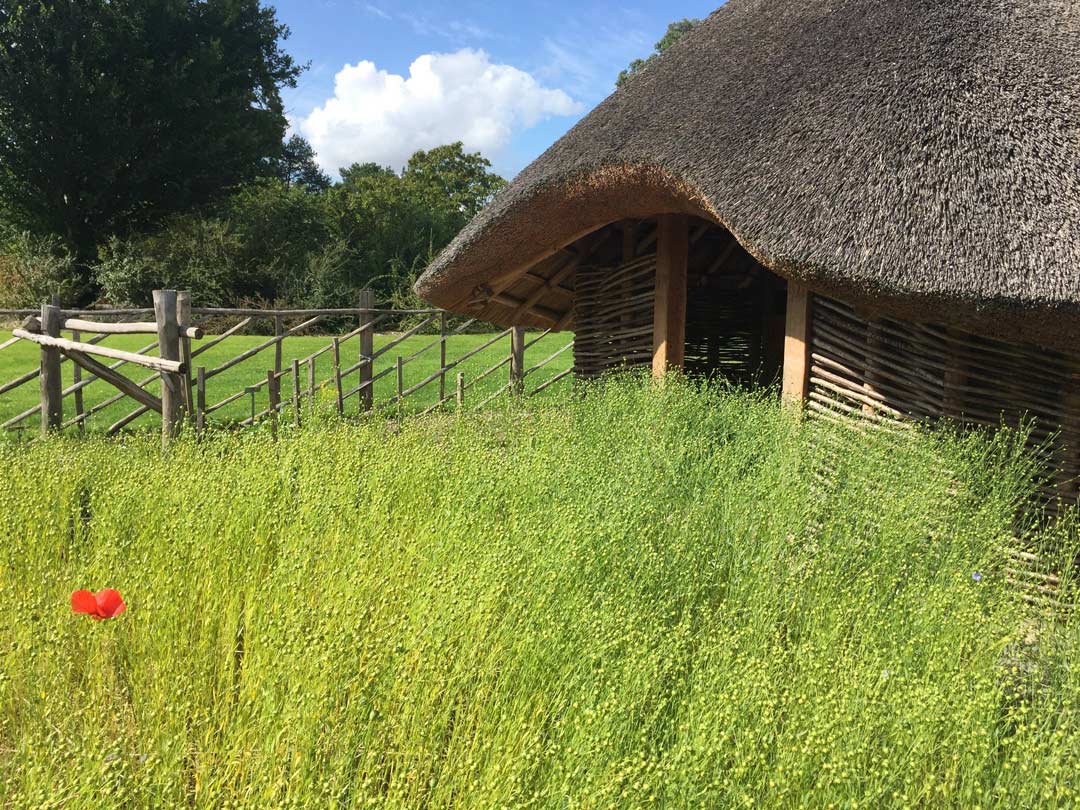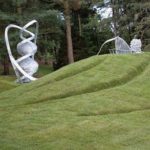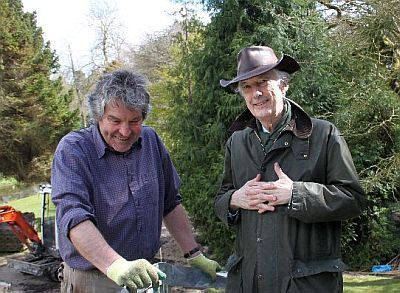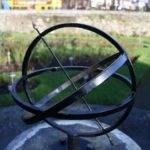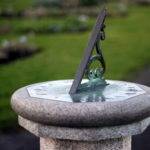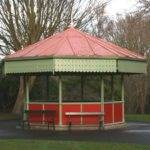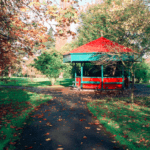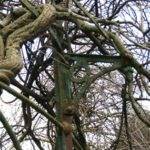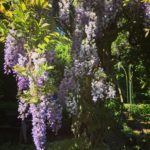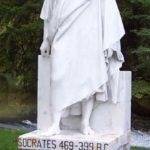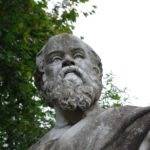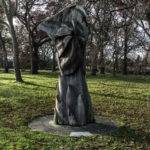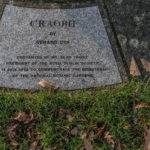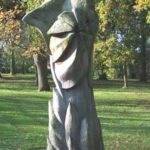Fascinating features hide behind every turn in the path at the National Botanic Gardens, Glasnevin.
Here we have selected a few highlights, but you will discover many more on your visit. The Gardens are open every day throughout the year except for Christmas Day, and are completely free to enter and explore. Interpretative guided tours are available Monday to Saturday for a small fee, and are free on Sundays. Click here for information on opening hours, and here for information about tours. The immensely popular Sculpture in Context exhibition is held annually in September in the Botanic Gardens, Glasnevin; these are temporary pieces produced in response to the Garden setting. Click here for more information on current and past exhibitions.
Scroll to end of this page for a map showing the location of each feature.
?What is Life?
Where, when and how did life first form? Water is essential for life, and indeed the two are virtually synonymous. Today it remains one of biology’s greatest mysteries, yet RNA, above all other molecules provides the greatest clue to What is life? The two greatest discoveries in the biologiical sciences – Darwin’s Natural Selection, and the structure of DNA – are thus embodied in this sculpture. Darwin’e remarkably prescient insight into molecular evolution is quoted on the first RNA molecule arising ‘in some warm little pond‘.
The sculpture ?What is life? was commissioned from Charles Jencks (1939 – 2019) to celebrate Science in Ireland, to encourage everyone, especially young people, to understand science and the role of science in society. Representing the flow of genetic information between DNA, RNA and protein, it was inaugurated by James Watson on the 60th anniversary (2013) of the discovery of The Double Helix by Watson and his colleague Francis Crick in April 1953. It represents for the first time in sculpture anywhere the many extraordinary new revelations made in the last 30 years about the novel roles of RNA in living organisms. Jencks was an American landscape designer and cultural theorist. He is known for his books questioning Modern architecture and defining its successors, and is the co-founder of the Maggie’s Cancer Care Centres. Educated at Harvard and London University he made his home in Scotland and London.
- The sculpture comprises the DNA double Helix surrounded by a rising waveform of RNA molecules.
- Alistair Clarke (left) and Charles Jencks (right) during construction of the sculpture.
Three scientists with strong Irish connections contributed to the work which led to the discovery of the Double Helical structure of DNA. The Austrian physicist and Nobel Prize winner Erwin Schrödinger (1887-1961) who delivered the famous lectures on ‘What is Life?’ in Dublin in 1943; John Bernal (1901-1971), who was born in Tipperary, and perfected the technique of X-Ray crystallography vital to the work of Maurice Wilkins (1916-2004) who was born in New Zealand of Irish parents, and was the third Nobel laureate along with Watson & Crick for the discovery of the structure of the Double Helix.
The creation of ?What is life? has been a partnership with John Atkins (University College Cork) whose passion for the RNA world has delivered the most up to date rendition of what we now ‘think’ we know about the world of Nucleic acids. Their collaboration has produced a melding of art and science that restores the pursuit of ‘natural philosophy’ so beloved of the Age of Enlightenment.
The Sundials
There are two sundials in the National Botanic Gardens, Glasnevin. One in front of the Palm House is the more familiar horizontal dial. This one was made in the mid eighteenth century by Lynch of 26 Capel Street, Dublin. It is one of the few dials in Ireland with a time-scale graduated in single minutes. It also features the names of other cities from Bombay to Rio de Janeiro, indicating the moment of solar midday for them. On the right, the cities of Madrid, London, Paris, and Rotterdam can be seen adjacent to the gnomon.
Across the Tolka river, in the Rose Garden, is a modern, armillary type dial. The arrow points directly at the North Star – Polaris. As the sun crosses the sky it casts a shadow from the shaft of the arrow on the inside of the ring that represents the equatorial line of the earth, giving the hour of the day. The shadow cast by this equatorial band against the ring supporting the arrow indicates the progression between the solstice dates (midwinter and midsummer days) through the equinox (Spring and Autumn).
The Bandstand
Built in 1894, the bandstand is in fact no more than a shelter which would never have accommodated a band.
Until the 1860s the conservatories were kept locked to the public, and by 1877 there were no more than three dozen seats in the entire garden. This building thus supplied much needed shelter and seating when it was built.
The Chaintent
The chaintent is a remarkable circular pergola erected some time after 1834 by the then head gardener Ninian Niven. Until 1870 it was centred by a weeping ash tree, from which the chains descended, but this was then replaced by an iron pole.
Today the pergola supports a number of venerable Wisteria plants.
Socrates
Records suggest that the statue of Socrates arrived in the gardens in 1959 from Iveagh House. The Annual Report of the Minister for Agriculture 1959-60 states that
Two marble figures representing Mercy and Socrates which had previously been in Iveagh House, St Stephens Green, Dublin, were erected in the Gardens and were much admired by visitors.
We now know that the ‘Mercy’ figure was actually Judith; a Carrara marble life-size figure sculpted by William Wetmore Story. It was exhibited in 1865 at the Dublin International Art Exhibition, and purchased by Sir Benjamin Lee Guinness ,and remained for many years in Iveagh House before reaching the National Botanic Gardens. Judith was removed by the OPW in the early 1990s to be restored and now stands in the entrance hall of Farmleigh House. Judith is recognised by her sword, with which she beheaded Holofernes, a general of King Nebuchadnezzar in the Book of Judith.
There are two old photographs of an identical looking sculpture of Socrates that was exhibited in Florence, Italy, in 1861 and at the London Exhibition in the following year as the work of the noted Italian sculptor Pietro Magni (1817 – 1877) of Milan. The similarities with the Glasnevin statue are striking, however, there are slight discrepancies between the images; these could be put down to the combination of lighting, camera angles and perhaps wear, tear.
In 1872 an exhibition of Fine Arts formed part of the ‘Dublin Exhibition of Arts, Industries and Manufactures’ held in Dublin’s Crystal Palace (now the site of the National Concert Hall). Among several pieces loaned to the Expo by Lord Iveagh (Edward Cecil Guinness) were several works by the same Pietro Magni. One of them was a sculpture entitled Socrates. This may well have been the same sculpture as shown earlier in Florence and London.
Lord Iveagh’s collection of sculptures, which included several by Magni, has been long dispersed save for a few that he left at his home in Farmleigh.
- Socrates. Cónal Thomas. Dublin Inquirer.
Craobh
Craobh, carved by Gerard Cox, was commissioned by the Royal Dublin Society, and presented by the President, Mr Sean Tinney, on the 11th July 1995 to commemorate the bicentenary of the National Botanic Gardens. The Irish word ‘craobh’ translates as the branch or bough of a tree. Craobh is a large wooden sculpture, and was created by carving straight into the trunk of a Hungarian oak tree.
The Viking House
The Viking House came about as a project to mark the millennium of the Battle of Clontarf in 1014. The enthusiastic support of Dublin City Council, the National Museum of Ireland and the School of Archaeology, University College Dublin is gratefully acknowledged. We received generous financial assistance from the Irish Museums Trust and Dublin City Council.
It was built between January and May 2014 by master craftsman Eoin Donnelly and thatched by Peter Compton. In 1961 excavations in the region of Wood Quay and Fishamble Street in Dublin revealed the perfectly preserved remains of Viking Dublin, dating from the 9th and 10th centuries. The building is an accurate recreation of one of these first Dublin houses based upon the archaeological evidence.
In Viking Age Dublin each house had a fence and a long plot of land in which they probably kept chickens and grew vegetables, fibre and dye plants. We know they ate a lot of wheat and barley as well as growing cabbages, beans and onions. Large quantities of bones from cattle sheep and pigs, as well as fish and shellfish from Dublin bay meant they had a healthy and varied diet. From the surrounding woodlands they would have harvested oak, ash and hazel to build their houses, which were probably thatched in reeds or sedges. These crop plants and trees are ground about the house to show the raw materials of their lives.
The house is open to school groups by appointment and as part of our guided tours (please ask at the Visitor Centre).
https://vimeo.com/88361363
